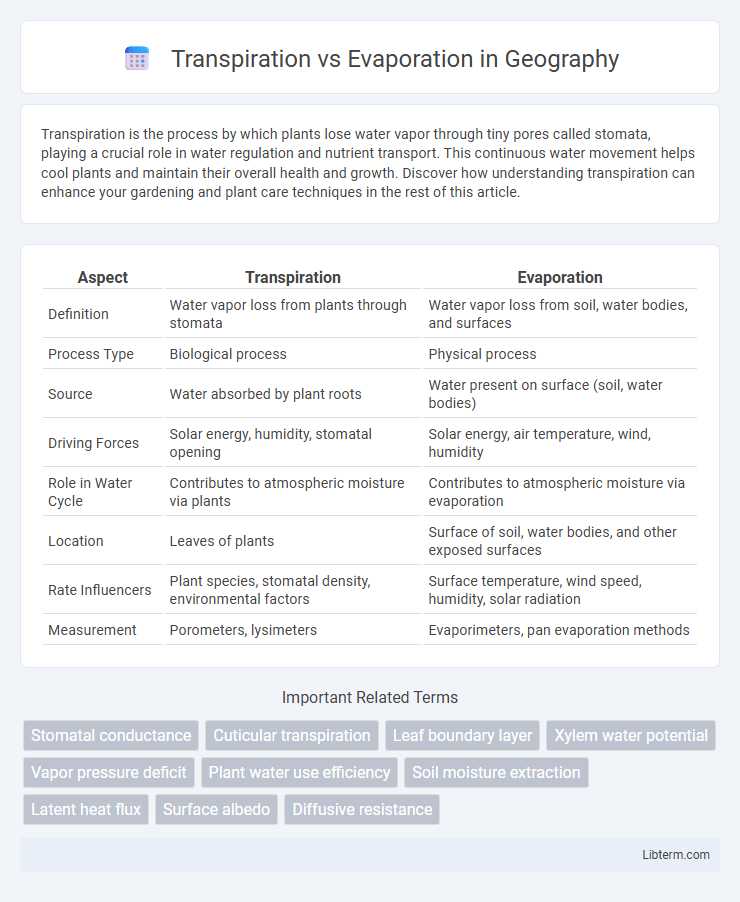Transpiration is the process by which plants lose water vapor through tiny pores called stomata, playing a crucial role in water regulation and nutrient transport. This continuous water movement helps cool plants and maintain their overall health and growth. Discover how understanding transpiration can enhance your gardening and plant care techniques in the rest of this article.
Table of Comparison
| Aspect | Transpiration | Evaporation |
|---|---|---|
| Definition | Water vapor loss from plants through stomata | Water vapor loss from soil, water bodies, and surfaces |
| Process Type | Biological process | Physical process |
| Source | Water absorbed by plant roots | Water present on surface (soil, water bodies) |
| Driving Forces | Solar energy, humidity, stomatal opening | Solar energy, air temperature, wind, humidity |
| Role in Water Cycle | Contributes to atmospheric moisture via plants | Contributes to atmospheric moisture via evaporation |
| Location | Leaves of plants | Surface of soil, water bodies, and other exposed surfaces |
| Rate Influencers | Plant species, stomatal density, environmental factors | Surface temperature, wind speed, humidity, solar radiation |
| Measurement | Porometers, lysimeters | Evaporimeters, pan evaporation methods |
Introduction to Transpiration and Evaporation
Transpiration is the process by which moisture is absorbed by plant roots, moves through plants, and is released as water vapor through stomata in the leaves. Evaporation involves the direct conversion of water from liquid to vapor form on surfaces such as soil, water bodies, and leaves, without biological involvement. Both processes contribute significantly to the water cycle, influencing humidity and climate regulation.
Defining Transpiration
Transpiration is the biological process where water absorbed by plant roots moves through stems and leaves, then vaporizes into the atmosphere via stomata. This process regulates plant temperature and nutrient transport while contributing significantly to the water cycle. Unlike evaporation, which occurs on all moist surfaces, transpiration is specific to living plants and involves active physiological mechanisms.
Defining Evaporation
Evaporation is the process by which water molecules transition from a liquid state to a gaseous state, typically occurring at the surface of water bodies due to heat energy from the sun. This phase change is crucial in the Earth's water cycle, contributing significantly to humidity and weather patterns. Unlike transpiration, which involves water loss through plant stomata, evaporation occurs from soil, water surfaces, and other moist surfaces independently of biological activity.
Key Differences Between Transpiration and Evaporation
Transpiration is the biological process where plants release water vapor from stomata, whereas evaporation is a physical process involving the conversion of water from liquid to vapor without biological involvement. Transpiration is regulated by plant physiology and environmental factors like light intensity and humidity, while evaporation depends primarily on temperature, surface area, and air movement. The rate of transpiration significantly affects plant water uptake and cooling, contrasting with evaporation, which mainly influences water loss from soil and open water bodies.
Biological Importance of Transpiration
Transpiration plays a vital role in maintaining plant health by regulating temperature and facilitating nutrient transport through the continuous movement of water from roots to leaves. Unlike evaporation, which is the simple physical process of water turning into vapor from surfaces, transpiration is a biological process essential for photosynthesis and growth. This water movement also helps sustain atmospheric humidity and drives essential gas exchange in plants, supporting overall ecosystem balance.
Environmental Role of Evaporation
Evaporation plays a crucial environmental role by regulating temperature and maintaining the water cycle through the conversion of liquid water into vapor from surfaces such as lakes, soil, and oceans. This process helps cool the environment by absorbing heat energy, thereby influencing local and global climate patterns. Furthermore, evaporation supports atmospheric moisture levels essential for precipitation and sustaining ecosystems.
Factors Influencing Transpiration
Transpiration is primarily influenced by factors such as temperature, humidity, wind speed, and light intensity, which affect the rate at which water vapor exits plant leaves through stomata. The availability of soil water and the plant's internal physiology, including stomatal density and leaf surface area, also significantly impact transpiration rates. Unlike evaporation, which occurs on any moist surface, transpiration is a biological process tightly regulated by the plant to balance water loss and nutrient uptake.
Factors Affecting Evaporation Rates
Evaporation rates are influenced by temperature, humidity, wind speed, and surface area, with higher temperatures and wind speeds accelerating water loss while increased humidity slows it down. Transpiration, unlike evaporation, involves water movement through plant stomata and is regulated by factors such as light intensity, soil moisture, and stomatal conductance. Understanding these factors is essential for optimizing water management in agriculture and environmental studies.
Examples in Nature and Everyday Life
Transpiration occurs in plants when water absorbed by roots evaporates from leaf surfaces, exemplified by the cooling effect in forests and garden plants. Evaporation takes place on exposed surfaces such as puddles drying after rain or sweat evaporating from human skin to regulate body temperature. Both processes are crucial for the water cycle and climate regulation, with transpiration contributing to atmospheric moisture and evaporation facilitating water transfer from soil and bodies of water.
Summary: Comparing Transpiration and Evaporation
Transpiration is the process where water is absorbed by plant roots and released as vapor through stomata, while evaporation involves the direct conversion of water from surfaces into vapor without biological mediation. Transpiration significantly influences the water cycle by contributing to atmospheric moisture via plant leaves, whereas evaporation primarily occurs from soil, water bodies, and other non-living surfaces. Understanding the distinction between transpiration and evaporation is crucial for modeling hydrological cycles and managing agricultural water use efficiently.
Transpiration Infographic

 libterm.com
libterm.com